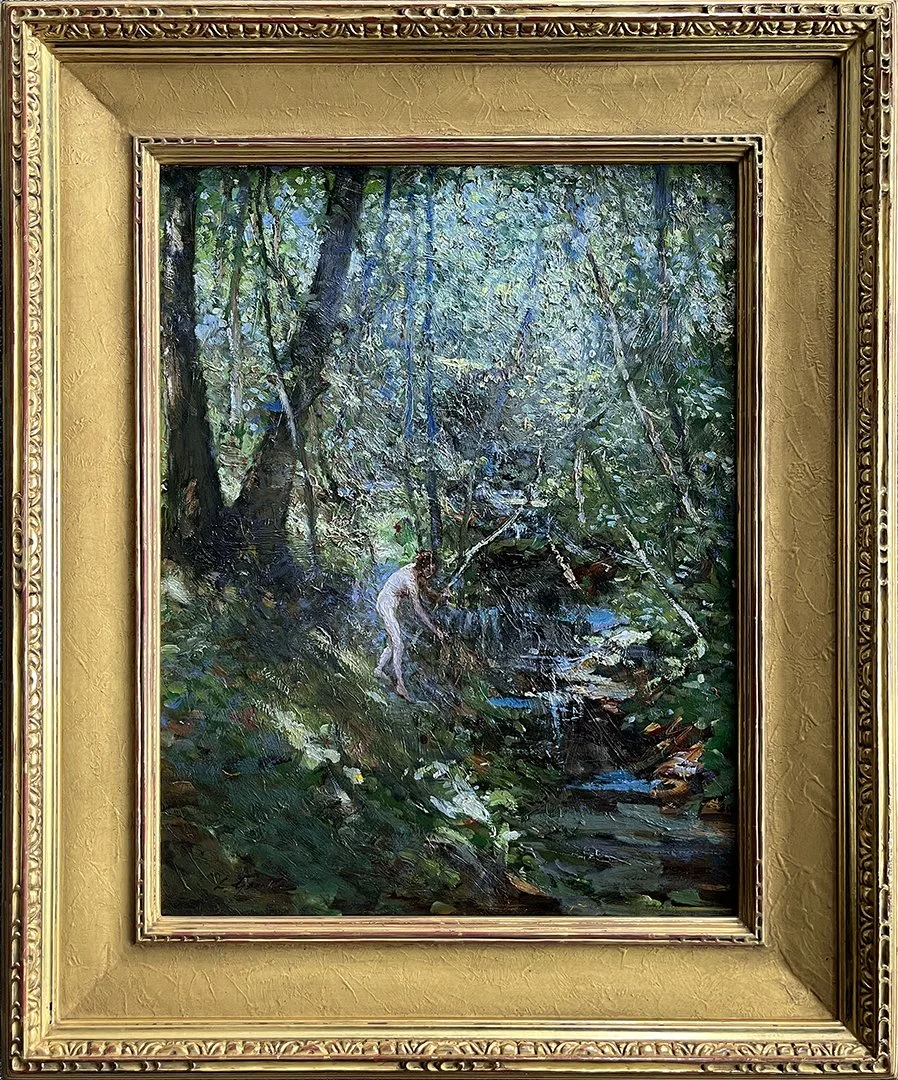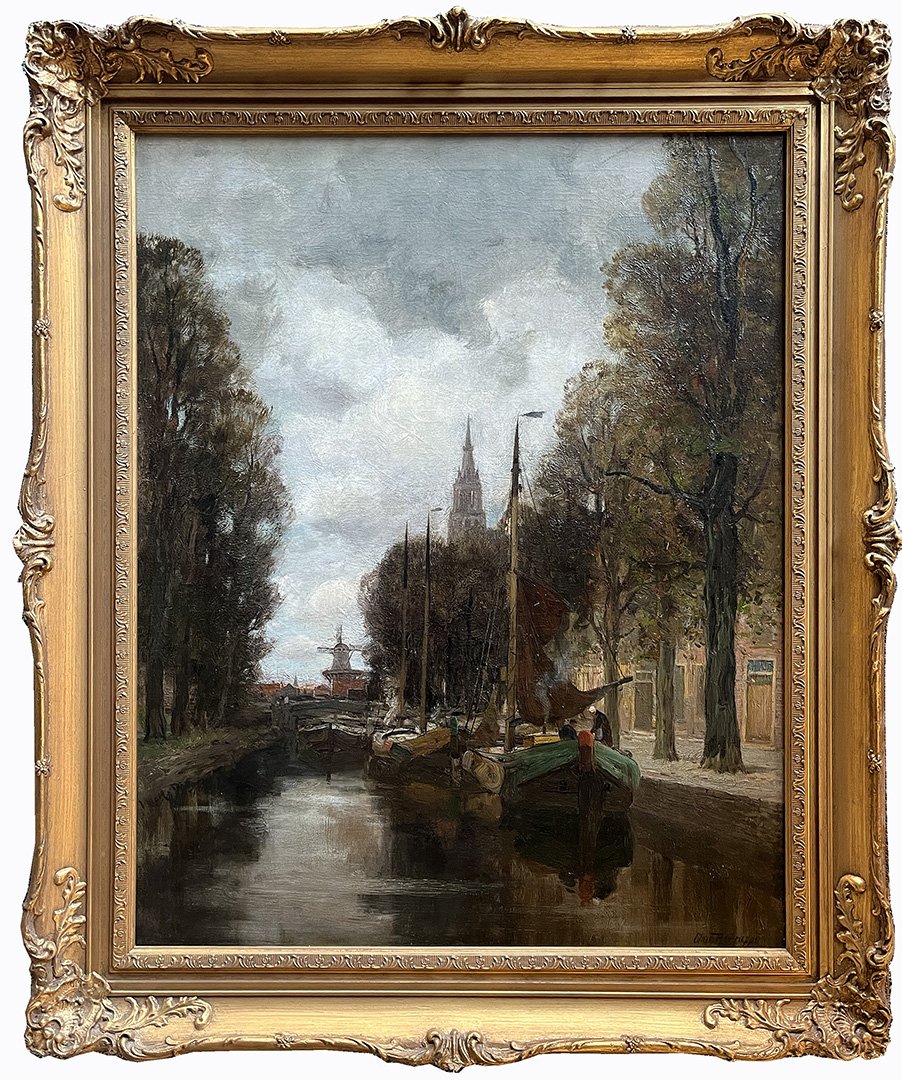Lillian Genth
Lillian Genth
Nude in a Garden
Oil on Canvas
23 x 18 inches
32 x 27 inches Signed Lower Left
ID: DH4358
Lillian Mathilde Genth (1876 – 1953) was an American impressionist artist. She is best known for her depiction of female nudes in landscape settings. However, in the middle of her career she swore off painting female nudes and began painting more conservative paintings inspired by her travels. In about 30 years Genth appeared in 233 exhibitions, and while well renowned for her paintings while alive, her story and artwork have been lost in the retelling of American art history.
During her time in Europe, Genth first settled in Paris, France in October 1900 where she enrolled in art classes at the Academie Carmen, an art school run by James McNeil Whistler. Whistler became a large influence on Genth’s work and she was known to be a favorite pupil of his. During one of Whistler’s visits to the school in 1900, he was so impressed by Genth’s work that he gave her a paint palette; an honor that she used and treasured for the rest of her career. This was an incredible compliment from Whistler, who rarely accepted women painters.
In 1904 Genth returned to the United States and was living in New York City. It was at this point that her career began to flourish. In 1904 Genth showed at three exhibitions: the National Academy of Design, Art Club of Philadelphia, and Worcester Museum and the Pennsylvania Academy of Fine Arts where she received the Mary Shaw Prize for the best landscape in the show for her work Peasant Houses, Normandy. Critics and the general public began noticing and appreciating Genth’s work during this beneficial year.
Through the next couple of years Genth continued to show at the nation’s most important art galleries, museums, and art clubs. In 1906 Genth developed her interest in the female nude. She quit drawing her European-inspired landscapes and focused on the female form. She quickly developed skills in drawing the nude female form and established her style that depicts nude females in landscape settings. When Genth was asked why she changed her form she responded, “Because to me the most beautiful thing in the world is the human figure outdoors. In Brittany, one day I took a model out and posed her in the open and I was at once filled with resentment at all the beauty I had been missing.”
The conservative Victorian society was not ready to accept Genth’s nude figures and at first her paintings were often rejected by exhibitions and advisors told her to abandon her new iconography. However, Genth, known for her fierce personality, persevered through these setbacks. In 1908 her painting, The Lark, won her the Shaw Memorial Prize at the 83rd Annual Exhibition of the National Academy of Design. The Lark depicts a full female nude strolling through the woods with her head turned looking toward the sky as if she just heard a lark, as the title suggests. This painting successfully demonstrates Whistler’s influence on Genth through the integration of the nude form and the landscape. The success of the painting relies on the focus of the painting as a whole to make the nude form grounded in the landscape instead of looking out of place.
Also in 1908, Genth was elected into the National Academy of Design as an Associate. She was the youngest woman ever elected to this position at the academy. From 1910 until 1929 Genth appeared in at least 164 exhibitions. During these years she experienced a lot of success, popularity, and wealth. She split her time between her two residences; one is an apartment in New York City, and the other is a large estate in the Berkshire Mountains in Connecticut, which she named Hermitcliff. Hermitcliff was an estate of 70 acres of woodland and it was here that Genth was able to paint her models uninterrupted. She loved coming to Hermitcliff and used it well throughout the years. She said about her beloved estate, “The things I have learned have come from the soil in the depths of my woods in Connecticut."
Throughout the 1920s Genth made multiple trips to Spain and became enamored with the sun and culture of the exotic country.
During her 1926 travels, Genth also stopped in North Africa to paint in the major cities. Genth was a curious woman and determined to find new and interesting subjects to paint and explore. She traveled alone and carried all of her materials and paintings with her and her time in North Africa was short but hectic. The art she made during these travels depicted a variety of different scenes of everyday life and portraits of the local women. In Genth’s own article “A Painting Trip in North Africa” she writes about stories from the trip and the experiences and hardships painting on the road. She discusses the vibrant markets and the foreign culture, but mainly describes the beautiful yet unique colors of the cities.
In 1931 Genth returned from a trip to Asia and announced that she would cease painting European and African subjects and focus on the Orient. When asked her reasoning, she simply said, “People live in cycles”. One of the main reasons for her trip was a commission from King Pradjadhipok, the King of Siam.
Genth first stopped in Japan to watch and paint sumo wrestling. While in Japan she also painted a series of Tokyo cityscapes, one of the most notable paintings being Theatre Street, Tokyo.
Genth then travelled to Hong Kong, China where she painted Hong Kong at night, a beautiful painting that contrasts the light and dark of the city from afar.
Next Genth travelled to Siam, which is present day Thailand, to paint for the king. In Bangkok, Thailand she created the painting, The Royal Barge, which depicts the king and his boats during the Water Festival.
Genth’s favorite stop in Asia was Papua because the island was very remote and fairly untouched by outsiders; a ship had not landed there in over four years.[2] In Papua she painted Papuan Wedding (Port Morsby), which captures a vibrant marriage ceremony with strokes of earth tones.
After Papua she traveled to Fiji, Bali, and Pago-Pago before returning to New York City.
Genth lived the rest of her life in New York City and showed in a few more exhibitions during the 1930s, but her shows became increasingly less frequent. In her later years she was driven to upstate New York every fall to witness the leaves change and painted small landscape sketches.
She died on March 28, 1953, at her home in New York City at age 76.





